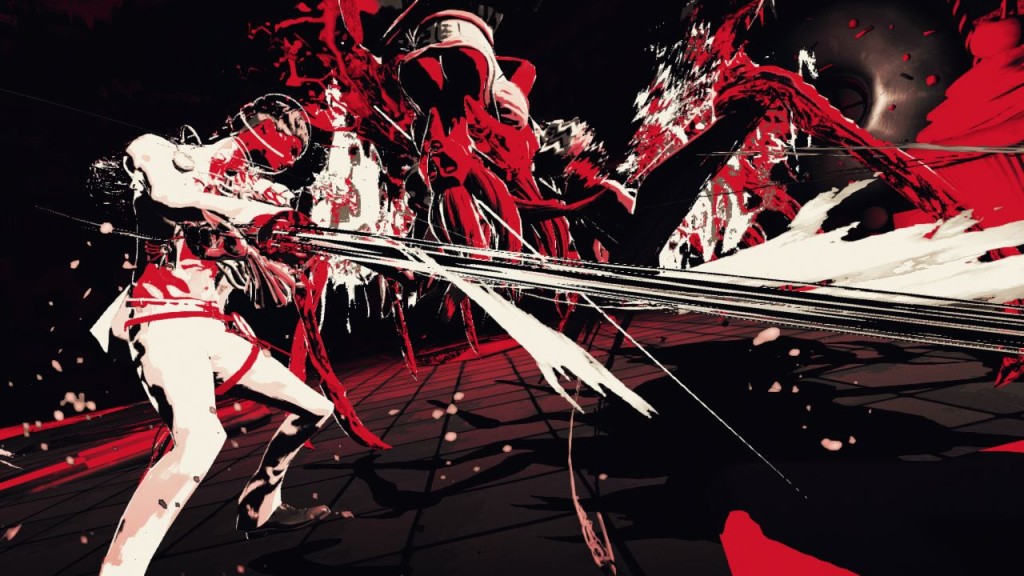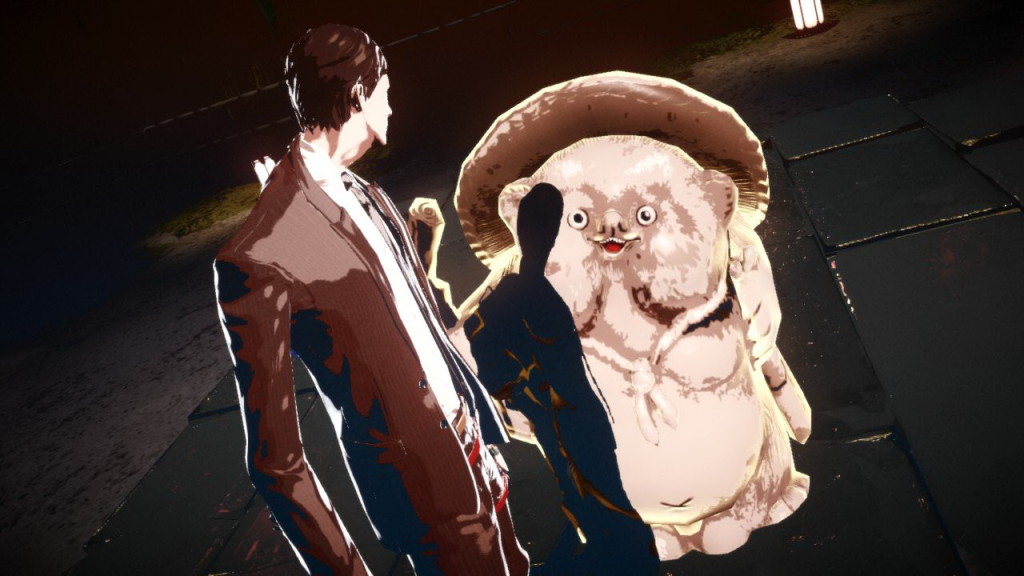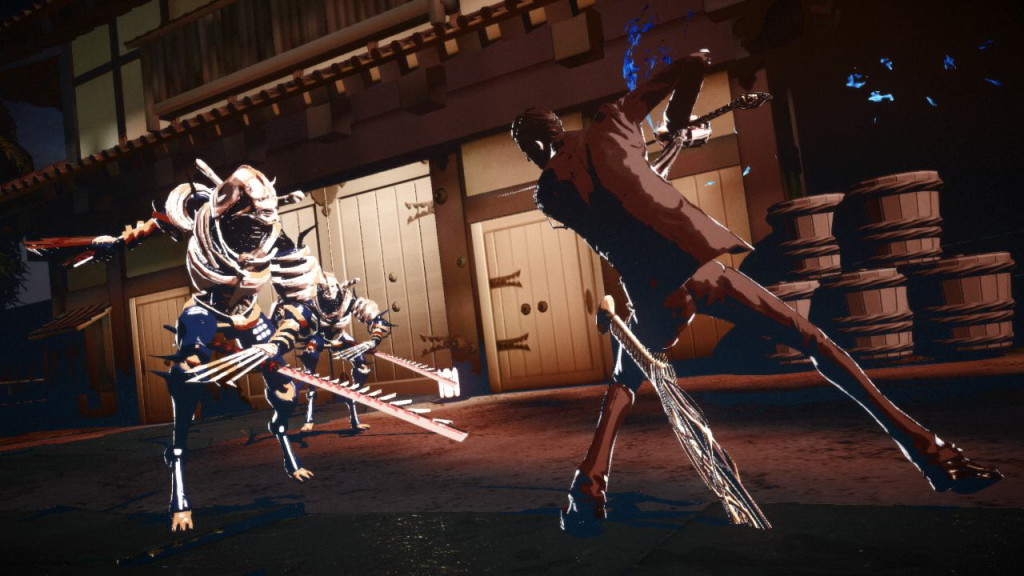Last updated on November 19, 2015
Killer Is Dead’s combat mechanics takes the usual “stylish action” tropes you’ve probably seen in a dozen such games. In this case, one button uses Mondo’s signature katana attack strings, which have little variation except to wail on the particular button in question. Pressing forward on the control stick while pressing the button does a forward charge slash similar to Dante’s Stinger, and pressing back lets Mondo’s dodge backwards and charge into the fray as a sort of feint. There are, of course, new moves to unlock via collectible items as is typical (such as the ability to juggle enemies in the air, and holding the button down for more attack variation), but it should seem fairly familiar at this juncture.
Instead of presenting multiple weapon configurations, Killer Is Dead provides two different functions for the Musselback, also known as Mondo’s bionic arm. The “guard break” button allows Mondo to attack enemies with his fist in combo strings and to (as the name says) break their guard, which you’ll need to do frequently. The second function suddenly turns Killer Is Dead into a third person shooter – if you hold the left trigger on your console/PC of choice, the game will suddenly put you into third person mode, wherein you can aim at enemies with Musselback’s default cannon and shoot with the right trigger. Because of this feature, ranged enemies appear frequently, and require switching to aiming mode in order to eliminate them. In fact, I’d call it one of the most effective uses of such a feature in a game of this type; the aiming mode often automatically sits on the nearest enemy, which can remove the guesswork and allow for quick aiming if the situation calls for it. That said, this feature does remove your wide angle of view which is typical of the genre, putting you in additional danger. Again, as typical of this genre, you can obtain multiple weapons for the Musselback, including a drill arm, an ice cannon, and a Mega Man-esque charge shot (a personal favorite).
Thankfully, Killer Is Dead also has a typical series of defensive options. You can block, as you might expect, but a good portion of the most dangerous attacks can only be dodged or countered. The counter attack proved especially useful, since hitting the block button at the exact point of contact also lets you perform an area-of-effect followup which effectively disrupts all enemies in close proximity (this is a later upgrade, but an important one). A dodge at the very last moment activates Burst Rush, which lets you teleport to that enemy and begin slashing wildly as long as you mash the sword button; these can be done in sequence, although it’s difficult to perform consistently. It isn’t quite like Bayonetta, considering you can’t dodge everything (some attacks, noted by the color purple as in Dark Matter, cannot ever be dodged) and the dodge timing is fairly strict, but it’s a competent system nonetheless.

Unfortunately, Killer Is Dead’s combat is, at times, unnecessarily punishing. The key to almost every combat situation in the game rests in the combo meter, located in the upper left hand corner of the UI. Hitting enemies continually generates blood; blood is necessary, not only to power Musselback’s various abilities, but also to quickly eliminate enemies via the Adrenaline Burst ability, which lets you kill enemies in one hit. Thus, you goal in nearly every fight will consist of 1. raising the combo meter as much as possible, usually around 25 hits 2. which raises your attack speed and 3. lets you kill enemies far more quickly. Getting hit, even once (with the exception of regular bullets, for some reason, most likely fairness), drops the combo meter in its entirety, meaning you end up at square one. Sure, you get to keep the blood, but it’s strange that the power up system works in this way.
That’s all the more problematic when you realize the enemy tells for attack and dodge timings aren’t clear. As per usual in Suda51-related games, the aesthetics often mar the game design; trying to tell when the active frames of an enemy attack occur is an exercise in trial and error that isn’t so much “fun” as “frustrating”. Sometimes, it appears perfect, only to still get hit. You can get hit immediately after a Burst Rush, which makes no sense given the dynamic camera angle makes it almost impossible to dodge immediately after that. Sometimes, when attacking an enemy, the camera simply zooms in for the more dramatic camera angle, at the detriment of your fighting abilities (this usually happens when using the guard break button, for whatever reason). Aiming mode prevents you from seeing the majority of the screen, and while you can dodge out of it, having that sort of spatial awareness is almost psychic. Further, Killer Is Dead loves throwing projectile enemies your way, especially ones with un-dodgeable attacks AND ranged enemies that spawn new projectile enemies. Sounding fun? Predicting these assaults just isn’t clear enough for the player to make good decisions.
Furthermore, the game’s camera does not work well within the environments of the game world at all. Clearly, you can tell a lot of work went into a wide, open arena-style combat (Scarlett’s combat challenges reveal this); for that purpose, in wide rooms, the camera works perfectly well, even if stylized. For close quarters and some of the cramped environments scattered throughout the game, however, situations quickly turn annoying. The camera literally obscures your view, and dodging enemy attacks feels like an exercise in combating the camera more than in genuine skill. Add the aforementioned projectile enemies into the mix, and Killer Is Dead often feels intentionally frustrating. With that said, the game often gives you too much in the way of health if you’re even basically competent at the game, which alleviates one problem while pointing out poor design in the other direction. The level design just exacerbates the problems, with too much of these small areas and bizarre (if diverse) methods of progress; nobody wants to play a scavenger hunt in a combat game really!

Even with these problems, the game’s primary mechanics remained genuinely fun from beginning to end. The game rejects the idea of creative combat expression, and more to fit into the shoes of a master assassin with a distinctive repertoire of combat techniques. Honestly, that lack of broad ideas means they could focus directly on the mechanics, which means that I enjoyed the game in spite of its frustration since the goals of combat were clear, if sometimes a bit clunky in practice. The system that underlies Killer Is Dead, from my perspective, is entirely solid. The shame of it is that the game’s level design simply doesn’t work with those mechanics. actively hindering their full expression. Surely, additional difficulty levels add some replay value, but I doubt I want to deal with all these combat problems with faster, more durable. No thanks!
Thus, the full story with Killer Is Dead seems as such: interesting story, only functionally competent (i.e., “average”) relative to its peers and genre contemporaries. While this might be the best combat system Grasshopper Manufacture created so far, it’s a vast improvement on their earlier work – it just needs some fine-tuning.

